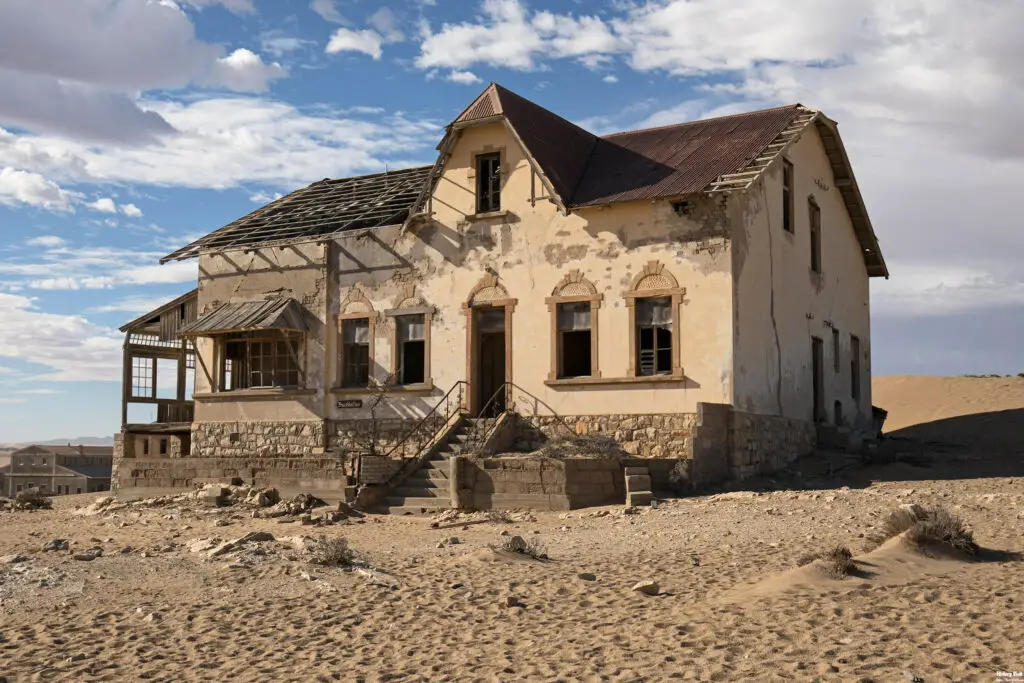Kolmanskop: Discover the Secrets of Namibia’s Enchanted Ghost Town!

Introduction
Kolmanskop, nestled in the Namib Desert, is one of Namibia’s most fascinating landmarks. Once a bustling diamond mining town, it now stands abandoned, a ghost town slowly being reclaimed by the sands of time. The rise and fall of Kolmanskop tell a poignant story of prosperity, decline, and the relentless power of nature. Established in the early 20th century by German settlers, Kolmanskop flourished during the diamond boom, only to be deserted decades later as diamond resources dwindled.
The town’s rapid rise was fueled by the discovery of diamonds in 1908, transforming a remote desert outpost into a thriving community. German architecture, complete with all the luxuries of the time, sprang up amidst the arid landscape, creating an unlikely oasis of prosperity. At its peak, Kolmanskop boasted amenities that rivaled those of European cities, including a hospital, school, theater, and even an ice factory.
However, the fortunes of Kolmanskop were tied to the finite diamond deposits beneath its sands. As the diamonds began to run out and new deposits were found elsewhere, the town’s decline was swift. By the 1950s, Kolmanskop was abandoned, its buildings left to the mercy of the encroaching desert. Today, it stands as a haunting reminder of the ephemeral nature of human endeavors, drawing tourists and photographers who are captivated by its eerie beauty.
Decline of Diamond Resources
The decline of Kolmanskop began as the diamond deposits, which had brought so much wealth and prosperity, started to dwindle. The initial boom years saw the extraction of vast quantities of diamonds, fueling rapid growth and development. However, as the easily accessible surface diamonds were exhausted, mining became more challenging and less profitable. The deeper layers of diamonds required more advanced and costly extraction techniques, which gradually eroded the profitability of the operations.
World War I also had a significant impact on Kolmanskop’s fortunes. The global conflict disrupted trade routes and economic stability, affecting the diamond market and the town’s economic viability. The war diverted resources and attention away from the mining industry, leading to a slowdown in production and investment. Additionally, the post-war economic conditions brought further challenges, as global demand for diamonds fluctuated and prices became unstable.
The final blow came when richer diamond deposits were discovered further south, near the Orange River. Mining companies, including the De Beers corporation, shifted their focus to these new, more profitable areas. This shift in operations led to a gradual exodus of residents from Kolmanskop, as miners and their families moved to more promising locations. By the 1930s, the population had significantly decreased, and the once-thriving town was on its way to becoming abandoned.
Abandonment

The abandonment of Kolmanskop was a gradual process, marked by the steady departure of its residents and the closure of its facilities. As the diamond industry moved south, the remaining inhabitants of Kolmanskop faced dwindling opportunities and a bleak future. Many of the town’s buildings, which had once housed vibrant communities and bustling businesses, were left empty and decaying. The last families left in the early 1950s, sealing the town’s fate as an abandoned relic of a bygone era.
The speed and extent of Kolmanskop’s abandonment were striking. Homes, shops, and public buildings were deserted almost overnight, leaving behind a snapshot of life frozen in time. Personal belongings, furniture, and tools were left as they were, creating an eerie and haunting atmosphere. The town’s infrastructure, including its railway station and hospital, fell into disrepair, with the relentless desert sands encroaching on every corner.
Nature quickly began to reclaim Kolmanskop, erasing the marks of human habitation. The Namib Desert, with its relentless winds and shifting dunes, began to engulf the abandoned buildings. Sand filled the rooms and hallways, creating surreal and haunting scenes of decay. The once orderly streets and gardens were overtaken by the desert, transforming Kolmanskop into a ghost town of sand-covered ruins. The abandonment of Kolmanskop was complete, and it became a silent testament to the impermanence of human endeavors.
Nature Reclaiming Kolmanskop

As Kolmanskop fell into abandonment, nature began to reclaim what was once its own. The Namib Desert, one of the oldest and most arid deserts in the world, slowly encroached upon the town, filling its buildings with sand and erasing the footprints of its former inhabitants. The relentless winds and shifting dunes created an ever-changing landscape, where the lines between human structures and natural formations blurred.
The encroachment of sand into the town’s buildings is one of the most striking features of Kolmanskop today. Rooms that once housed families, schools, and businesses are now filled with fine desert sand, creating a surreal and haunting sight. Staircases lead to rooms buried in sand, windows frame views of endless dunes, and doorways open into vast, sandy interiors. The contrast between the decaying structures and the pristine beauty of the desert creates a unique and eerie atmosphere that captivates visitors.
The abandonment and natural reclamation of Kolmanskop have also led to a unique ecological environment. Despite the harsh conditions, the desert supports a variety of life, including hardy plants and resilient animals. The ruins of Kolmanskop provide shelter for birds and small mammals, while desert-adapted plants take root in the sandy soil. This blend of human history and natural beauty makes Kolmanskop a fascinating site for both tourists and researchers, who are drawn to its haunting allure and ecological significance.
Conclusion

Kolmanskop’s story is a poignant reminder of the transient nature of human achievements and the relentless power of nature. Once a thriving diamond mining town, it now stands abandoned, a ghost town slowly being reclaimed by the desert. The rise and fall of Kolmanskop highlight the boom-and-bust cycles that have shaped many industrial communities around the world. Its rapid growth, driven by the discovery of diamonds, was followed by a swift decline as resources dwindled and economic conditions changed.
Today, Kolmanskop serves as a haunting and beautiful reminder of Namibia’s rich history and the impermanence of human endeavors. Its abandoned buildings and sand-filled rooms offer a unique glimpse into the past, attracting tourists, photographers, and historians from around the world. The town’s eerie beauty and the stark contrast between human structures and natural landscapes create a powerful and evocative image of a world left behind.
As we reflect on the story of Kolmanskop, we are reminded of the importance of sustainable development and the need to balance human progress with environmental preservation. The lessons learned from Kolmanskop’s rise and fall can inform our approach to future industrial and economic projects, ensuring that we create communities that are resilient, adaptable, and in harmony with the natural world.


